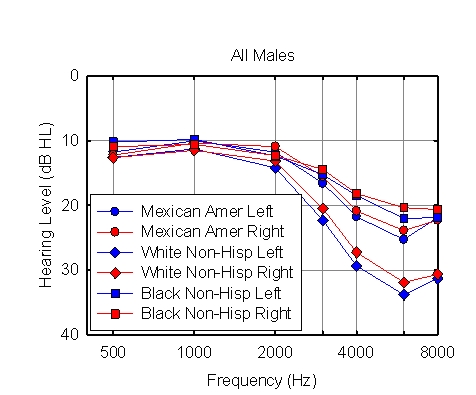151st ASA Meeting, Providence, RI
Hearing Levels in US Adults
William J. Murphy, Ph.D. - wjm4@cdc.gov
Popular version of paper 2aPPb5
Recent data from the National Health and Nutrition Examination Survey (NHANES) indicate that hearing ability among American adults has remained fairly stable over the past thirty years. The data also confirm that hearing loss increases with age and that hearing difficulty is more prevalent among men than women and among non Hispanic whites compared to non Hispanic blacks and Hispanic adults. NHANES, the gold standard of assessing the health and nutritional status of the American population, collects data through a personal interview and physical examination of a nationally-representative sample. This data is used to determine the nation's public health needs, such as interventions to prevent hearing loss. Prior estimates have suggested that at least 28 million people in the United States are deaf or hard-of-hearing and that 17% of adults have some level of hearing trouble. These estimates were made by asking individuals to rate their own hearing. Since people often do not recognize that they have a hearing loss, the prevalence of hearing loss based on self-reports can be underestimated. NHANES, on the other hand, conducts examinations (i.e., audiometric testing) to more accurately estimate the prevalence of US adult hearing trouble. Over the period 1971-1975, NHANES I tested hearing in a nationally-representative sample of Americans aged 25-75 years. Although the survey was periodically repeated, hearing testing of adults was not included again until 1999-2004, when NHANES tested hearing levels of US adults aged 20-69 years. The National Institute for Occupational Safety and Health (NIOSH) compared the NHANES 1999-2004 data to NHANES I data from 35 years ago and found little change in the mean (average) hearing levels of US adults. Overall, hearing thresholds (i.e., the softest sound a person can hear) show the expected decline with age across all races and genders. Women tend to have poorer low frequency hearing than men; but men show poorer hearing at higher frequencies in NHANES 1999-2004. The 1999-2004 data also show that non Hispanic blacks have the best hearing thresholds and non Hispanic whites have the poorest hearing thresholds. The following three figures illustrate mean hearing thresholds across all sound frequencies (or pitches) tested in the current NHANES by gender and race. Frequencies (measured in hertz [Hz] are represented horizontally across the graphs with low pitches on the left and increasingly higher pitches on the right (similar to playing on the left side of a piano and gradually moving to the right side). Hearing level (measured in decibels [dB] is represented vertically down the side of the graph, with softer sounds towards the top and louder sounds farther down. Conversational speech is between 500 Hz and 3000 Hz with a sound level between 50 and 60 dB. 
 
Hearing loss can be caused by a myriad of factors, such as age, noise exposure (occupational or recreational), developmental syndromes, infectious disease, physical trauma, ototoxic drugs and chemicals, all of which may be influenced by genetic susceptibility. However, it is estimated that at least one third of the cases of hearing impairment stem from overexposure to noise. Estimates of noise exposure in the United States vary, but range from 5 to 30 million persons exposed in the workplace and 16 to 66 million exposed recreationally. Effective prevention programs could therefore make a large impact in reducing the prevalence of hearing loss in the United States.
|